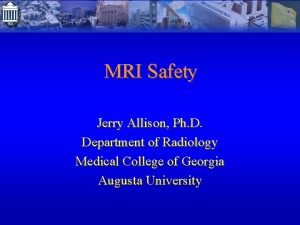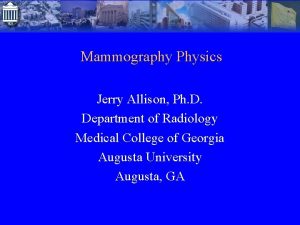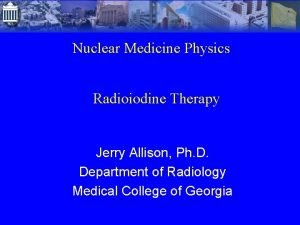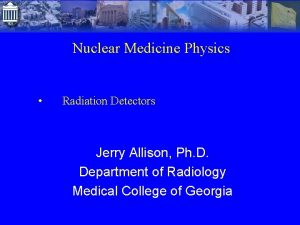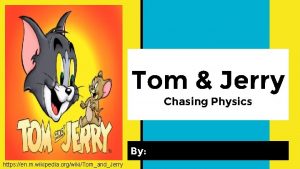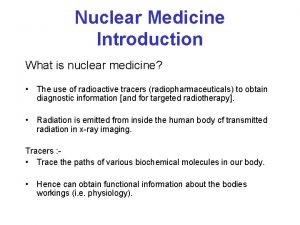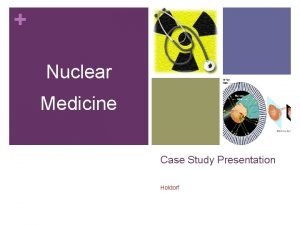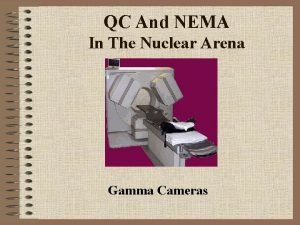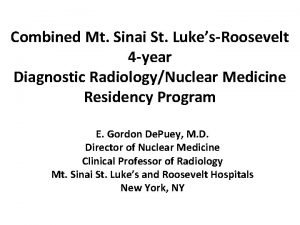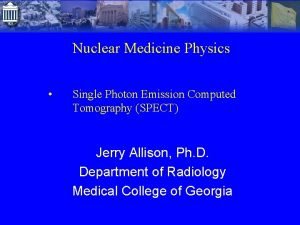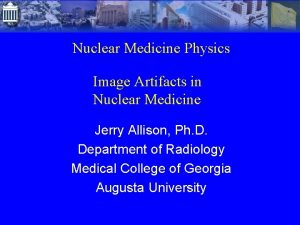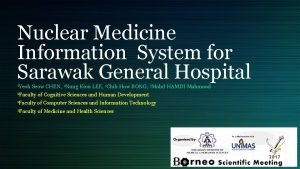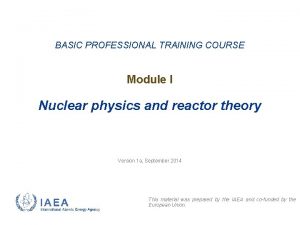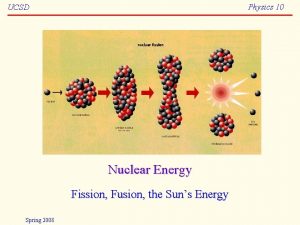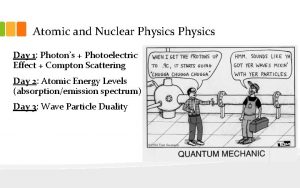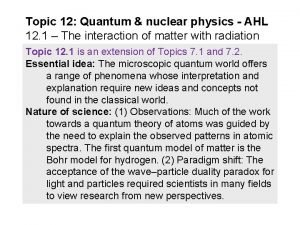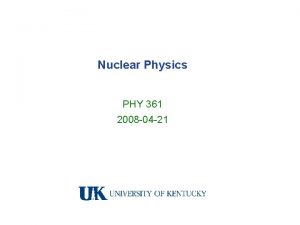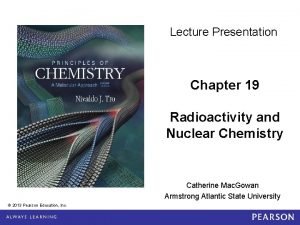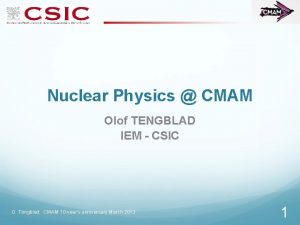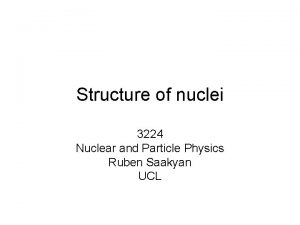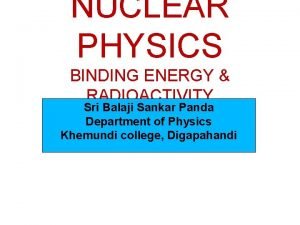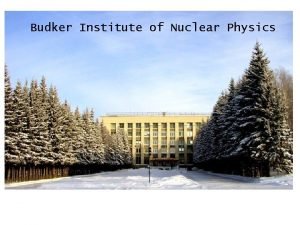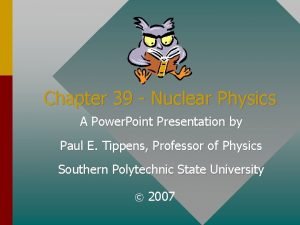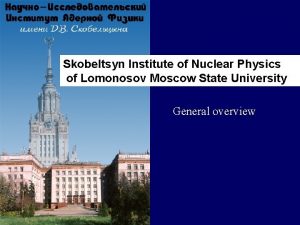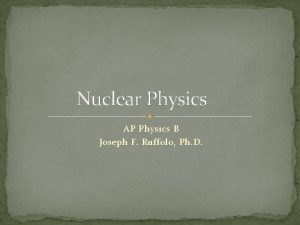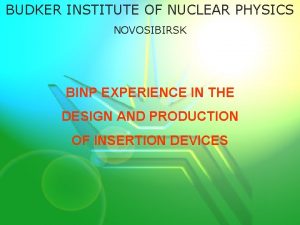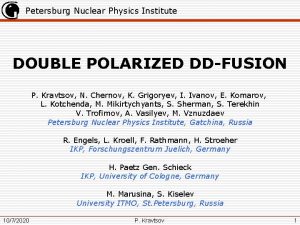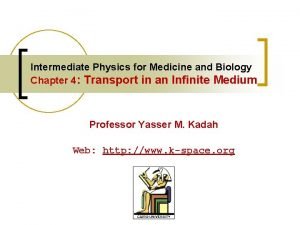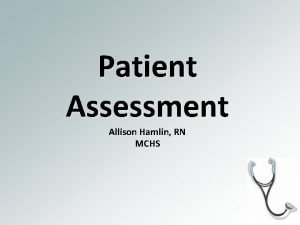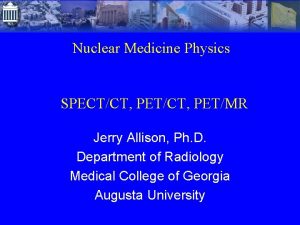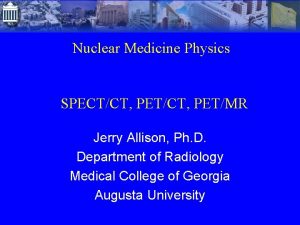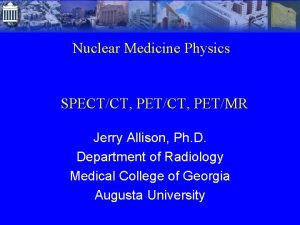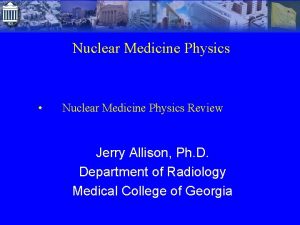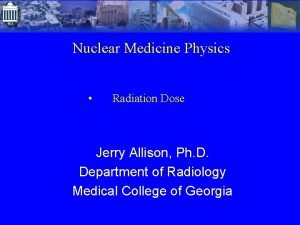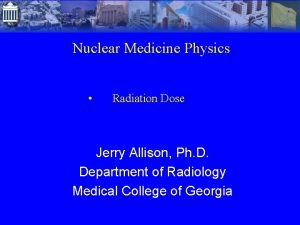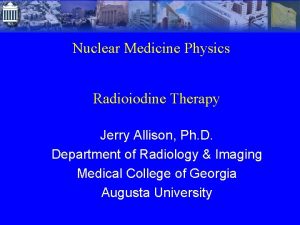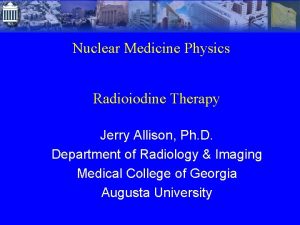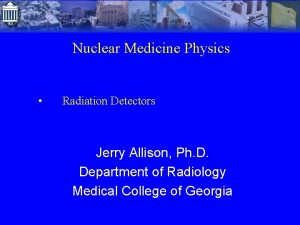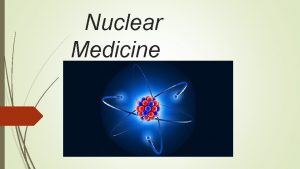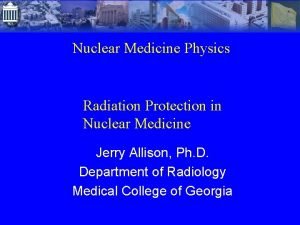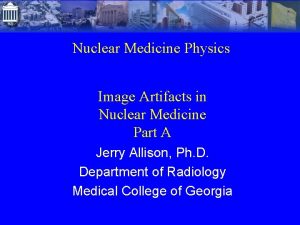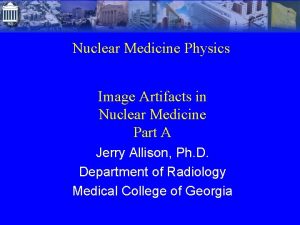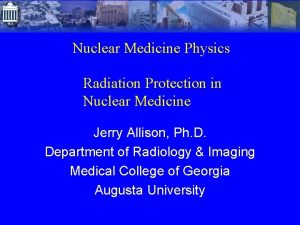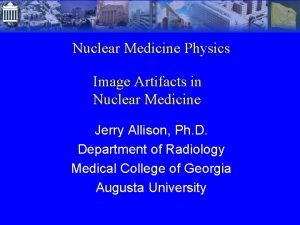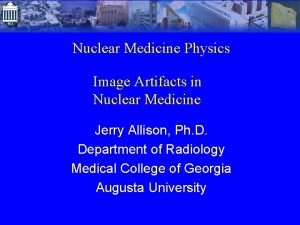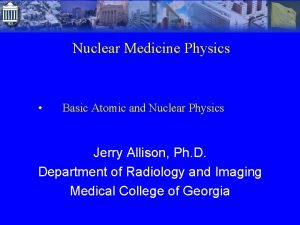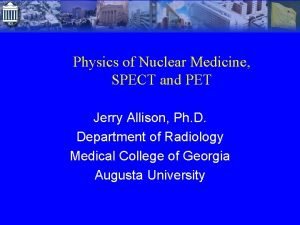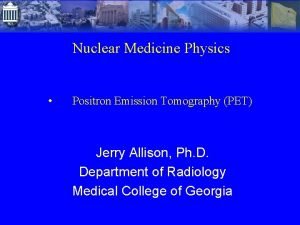Nuclear Medicine Physics SPECTCT PETMR Jerry Allison Ph









































- Slides: 41

Nuclear Medicine Physics SPECT/CT, PET/MR Jerry Allison, Ph. D. Department of Radiology Medical College of Georgia Augusta University

A note of thanks to Z. J. Cao, Ph. D. Medical College of Georgia And Sameer Tipnis, Ph. D. G. Donald Frey, Ph. D. Medical University of South Carolina for Sharing nuclear medicine presentation content

SPECT vs PET SPECT (Step-and-shoot acquisition) 2015 (Simultaneous acquisition) Nuclear Medicine Physics for Radiology Residents Sameer Tipnis, Ph. D, DABR

SPECT vs PET imaging Attribute SPECT PET Detection Single s Coincident s 99 m. Tc, 67 Ga, 18 F, 82 Rb, 13 N, Radionuclides 111 In E 70 – 300 ke. V 511 ke. V Spatial res. 10 – 12 mm 5 - 6 mm Atten. Correction Yes* * Possible with CT hybrids 2015 Nuclear Medicine Physics for Radiology Residents Sameer Tipnis, Ph. D, DABR

SPECT & PET • SPECT – multiple views from many angles § Res. collimator res. , which degrades rapidly with increasing distance from collimator face • PET – Simultaneous acquisition § Res. detector width; is max in center of ring • SPECT sensitivity ~ 0. 02% § Huge losses due to absorptive collimators • PET sensitivity- 2 D ~ 0. 2%; 3 D ~ 2% or higher § High sensitivity due to ACD (annihilation coincidence detection: electronic collimation) § Allows better spatial resolution 2015 Nuclear Medicine Physics for Radiology Residents Sameer Tipnis, Ph. D, DABR

SPECT/CT, PET/MR • Combine a PET scanner (or gamma camera) with a CT (or MR) scanner on the same gantry to share the same patient table • Acquire CT (or MR) and PET (or SPECT) images sequentially (or simultaneously) with minimum patient movement and then use software to fuse the images 6

Why PET/CT, PET/MR, and SPECT/CT? • Fusion of PET (or SPECT) and CT (or MR) images provides a clear anatomic background for tumors and hence better tumor localization. • CT image provides a patient-specific attenuation map for PET (or SPECT) attenuation compensation. 7

PET/CT scanner • First PET/CT scanner: 1998 • Currently all PET scanners have CT.

SPECT/CT scanner Introduced in early 2000’s Notice cone beam CT

PET/CT image fusion 10

SPECT/CT images Oncology

From CT image to attenuation map • Fundamentally, reconstructed data in CT represent the linear attenutation coefficient ( ) for each image voxel • For image display, the linear attenuation data is converted to CT numbers or Hounsfield units • CT (x, y) = 1000 * (x, y) – water (x, y) • -1000 is air; 0 is water; 3000 is bone/contrast 12

From CT image to attenuation map • Attenuation coefficient depends on photon energy. • The average energy of CT x-rays is ~70 ke. V while the photons are 511 ke. V in PET or 140 ke. V in SPECT. • CT image is segmented to bone, muscle, and lungs. • Apply different scaling factors (e. g. 511/ 70 for PET) to tissues, e. g. 0. 495 to muscle and 0. 406 to bone, to convert the CT image to map. 13

Artifacts in PET (or SPECT) caused by CT § Since CT image is used for PET (or SPECT) attenuation compensation, CT image artifacts may cause artifacts in PET (or SPECT) reconstructed image. § CT artifacts may be caused by • metal, patient movement, or image truncation, • contrast • misalignment between CT and PET (or SPECT) due to respiration and other patient motions. 14

Respiration misalignment in PET/CT AC corrected PET 15

Misalignment in SPECT/CT 16

Misalignment in SPECT/CT 17

Head motion in PET Corrected 18

PET/MR • Functional and anatomic image fusion, MR provides better soft tissue contrast than CT better lesion localization particularly in brain imaging • No ionizing radiation to the patient from MR so radiation dose is cut down to about half • It is difficult to obtain patient-specific MRbased attenuation map for PET reconstruction. 19

Sequential PET/MR • PET separated from MR but sharing the same patient table. Data acquisition is sequential, e. g. Philips TF Ingenuity (PET + 3 T MR) 20

Simultaneous PET/MR • PET inserted in the MR ring so that the data acquisition is truly simultaneous, e. g. Siemens Biograph m. MR (PET + 3 T MR) 21

Main technical challenges of PET/MR • Reduce the interference between PET and MR components. § PMT replaced by avalanche photodiodes, or § PMT installed far away from the MR ring using long optical fibers § PET electronics shielded from RF and gradient fields § MR coils shielded from the metal PET insert • Patient-specific, MR-based attenuation map for PET attenuation compensation? !? ! 22

PET/MR human brain PET MRI fused

PET/MR human brain PET/CT PET/MR w. o. AC PET/MR CT-based PET/MR MR-based AC AC

PET/MRI breast cancer MRI fused PET

Attenuation Correction: A Review 2015 Nuclear Medicine Physics for Radiology Residents Sameer Tipnis, Ph. D, DABR

Attenuation correction • s traveling smaller paths through pt (nearer to detector) have less attenuation compared to those from deeper in pt § Inaccurate representation for the distribution of radioactivity § AC allows improved representation of the distributed radioactivity 2015 Nuclear Medicine Physics for Radiology Residents Sameer Tipnis, Ph. D, DABR

Attenuation correction • SPECT: for AC can be assumed or measured § Chang (assumed), Measured - Gd rods (older) or CT (new) § CT can be non-diagnostic (low power) or fully diagnostic • PET: for AC is measured § CT (fully diagnostic) 2015 Nuclear Medicine Physics for Radiology Residents Sameer Tipnis, Ph. D, DABR

Attenuation in SPECT D 1 a I 1 = I 0 e- a t I 0 = I 1 e+ a Probability of detection / correct intensity I 0, dependent on the depth at which originates need to know “a” 2015 Nuclear Medicine Physics for Radiology Residents Sameer Tipnis, Ph. D, DABR

Chang’s AC method • SPECT image first reconstructed without AC • Contours of image used to estimate t for each projection, assumed to be constant (0. 12/cm) • ACF determined for every projection • Average ACF determined for each pixel (x, y) from all projections • Reconstructed image corrected pixel-by-pixel • Works well for area with approximately constant attenuation like head, abdomen but not for areas like chest / thorax or pelvis 2015 Nuclear Medicine Physics for Radiology Residents Sameer Tipnis, Ph. D, DABR

Uniform phantom with evenly distributed 99 m. Tc Low counts in center 2015 Chang method Proper AC Nuclear Medicine Physics for Radiology Residents Chang method Overcorrection Sameer Tipnis, Ph. D, DABR

SPECT-CT

AC in SPECT CT • Accurate / realistic -map obtained for each projection using CT • values used to correct images pixel-by-pixel • AC here is more realistic (since is not assumed to be constant) • Current SPECT/CT systems use this method 2015 Nuclear Medicine Physics for Radiology Residents Sameer Tipnis, Ph. D, DABR

Attenuation in PET b D 1 D 2 a P 1 = e- a t P 2 = e- b P = P 1 × P 2 = e- a × e- b = e- (a+b) = e- t Probability of detection dependent only on the total thickness

Attenuation Correction in PET/CT 2015 Nuclear Medicine Physics for Radiology Residents Sameer Tipnis, Ph. D, DABR

Attenuation Correction Without AC With AC 2015 Nuclear Medicine Physics for Radiology Residents Sameer Tipnis, Ph. D, DABR

Attenuation in PET • For each LOR, probability of detection dependent only on the total thickness • Every point along LOR has SAME ACF (No depth dependance) thus • Attenuation easier to correct than in SPECT • By far the most important data correction in PET 2015 Nuclear Medicine Physics for Radiology Residents Sameer Tipnis, Ph. D, DABR

PET/CT co-registration • • 2015 After acquisition, check PET / CT registration • Scanners have manual QC tool for checking co-reg • If unsatisfactory, adjust co-reg using QC tool and repeat PET reconstruction Proper co-registration of PET and CT data is critical for proper diagnosis Nuclear Medicine Physics for Radiology Residents Sameer Tipnis, Ph. D, DABR

Attenuation Correction Proper registration Misregistration Lateral walls of myocardium in the PET data, corrected with the lower attenuation of lung tissue Lateral walls of myocardium corrected with the higher attenuation of heart tissue (Ref: Attenuation correction of PET cardiac data with low-dose average CT in PET/CT, Tinsu Pan et al, Med. Phys. 33, October 2006) 2015 Nuclear Medicine Physics for Radiology Residents Sameer Tipnis, Ph. D, DABR

Typical PET / CT imaging (1) (2) 512 x 512 128 x 128 120 k. Vp 511 ke. V 2015 Nuclear Medicine Physics for Radiology Residents Sameer Tipnis, Ph. D, DABR

• October 7, 2015 -- Researchers at the University of California, Davis (UC Davis) have received a five-year, $15. 5 million grant to develop what they are calling the world's first total-body PET scanner. § National Cancer Institute and will fund the Explorer project, led by Simon Cherry, Ph. D, distinguished professor of biomedical engineering and Ramsey Badawi, Ph. D, a professor of radiology. § The total-body PET scanner would image an entire body all at once, and it would acquire images much faster or at a much lower radiation dose by capturing almost all of the available signal from radiopharmaceuticals. … the design would line the entire inside of the PET camera bore with multiple rings of PET detectors. § … such a total-body PET design could reduce radiation dose by a factor of 40 or decrease scanning time from 20 minutes to 30 seconds http: //www. auntminnie. com/index. aspx? se c=sup&sub=mol&pag=dis&Item. ID=112051 41
 Jerry allison
Jerry allison Jerry allison
Jerry allison Jerry allison
Jerry allison Jerry allison
Jerry allison Lesson 15 nuclear quest nuclear reactions
Lesson 15 nuclear quest nuclear reactions Fisión nuclear vs fision nuclear
Fisión nuclear vs fision nuclear Tom chasing jerry
Tom chasing jerry Types of nuclear medicine
Types of nuclear medicine Conclusion for case study
Conclusion for case study Intranet
Intranet Edge packing
Edge packing Mt sinai nuclear medicine
Mt sinai nuclear medicine Filtered back projection
Filtered back projection Septal penetration artifact
Septal penetration artifact Nuclear medicine information system
Nuclear medicine information system Nuclear medicine lectures
Nuclear medicine lectures Nuclear physics
Nuclear physics Nuclear energy
Nuclear energy Nuclear physics day
Nuclear physics day Physics topic 12
Physics topic 12 Quantum and nuclear physics
Quantum and nuclear physics Nuclear physics
Nuclear physics Magic number
Magic number Scattering cross section in nuclear physics
Scattering cross section in nuclear physics Nuclear physics
Nuclear physics Magic number in nuclear physics
Magic number in nuclear physics Nuclear physics
Nuclear physics Nuclear physics
Nuclear physics Budker
Budker Nuclear physics topics for presentation
Nuclear physics topics for presentation Skobeltsyn institute of nuclear physics
Skobeltsyn institute of nuclear physics Nuclear physics b
Nuclear physics b Budker
Budker Petersburg nuclear physics institute
Petersburg nuclear physics institute Intermediate physics for medicine and biology
Intermediate physics for medicine and biology Allison
Allison Allison lackie
Allison lackie Kohl's organizational chart
Kohl's organizational chart Allison horst
Allison horst Allison tayler
Allison tayler Allison hamlin
Allison hamlin Allison vaillancourt
Allison vaillancourt
